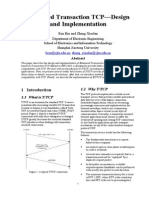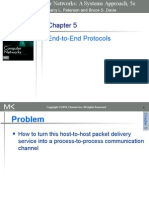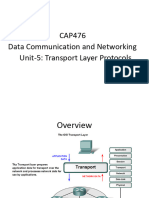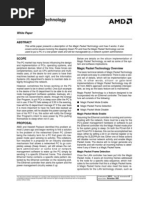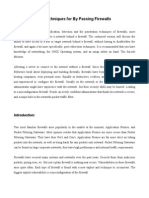CN Notes-Unit V
CN Notes-Unit V
Uploaded by
api-278882881Copyright:
Available Formats
CN Notes-Unit V
CN Notes-Unit V
Uploaded by
api-278882881Original Title
Copyright
Available Formats
Share this document
Did you find this document useful?
Is this content inappropriate?
Copyright:
Available Formats
CN Notes-Unit V
CN Notes-Unit V
Uploaded by
api-278882881Copyright:
Available Formats
Computer Networks [10MCA32]
UNIT V
1. Explain the format of UDP header and UDP message queue.
The User Datagram Protocol (UDP) is a end-to-end transport protocol.
The issue in UDP is to identify the target process.
The approach used by UDP is to indirectly identify each other processes using an abstract locator,
often called a port or mailbox.
The basic idea is for a source process to send a message to a port and for the destination process to
receive the message from a port.
The next issue is how a process learns the port for the process to which it wants to send a message.
Typically, a client process initiates a message exchange with a server process.
Once a client has contacted a server, the server knows the clients port (it was contained in the
message header) and can reply to it.
The real problem, therefore, is how the client learns the servers port in the first place.
A common approach is for the server to accept messages at a well-known port.
That is, each server receives its messages at some fixed port that is widely published.
In the Internet, for example, the domain name server (DNS) receives messages at well-known port
53 on each host, the mail service listens for messages at port 25, and the Unix talk program accepts
messages at wellknown port 517, and so on.
The header for UDP contains an identifier (port) for both the sender (source) and the receiver
(destination) of the message.
SrcPort, DstPort - It can be a client or server. If client, the port number is called ephemeral. If it is a
server, then the server has a well known port number.
Length - This field gives the length of the entire UDP.
Checksum - Used to check errors in transmission.
Typically, a port is implemented by a message queue, as illustrated in the Figure.
When a message arrives, the protocol (e.g., UDP) appends the message to the end of the queue.
When the queue is full, the message is discarded.
There is no flow-control mechanism that tells the sender to slow down.
When an application process wants to receive a message, one is removed from the front of the
queue. If the queue is empty, the process blocks until a message becomes available.
Finally, although UDP does not implement flow control or reliable/ordered delivery, it does a little
more work than to simply demultiplex messages to some application processit also ensures the
correctness of the message by the use of a checksum.
Mrs. Reena Vimal A. G.
Dept. of MCA, TOCE.
Computer Networks [10MCA32]
UDP computes its checksum over the UDP header, the contents of the message body, and something
called the pseudoheader. The pseudoheader consists of three fields from the IP headerprotocol
number, source IP address, and destination IP address plus the UDP length field.
The pseudoheader is used to verify that this message has been delivered between the correct two
endpoints.
For example, if the destination IP address was modified while the packet was in transit, causing the
packet to be misdelivered, this fact would be detected by the UDP checksum.
2. Explain the TCP header format with suitable diagram.
TCP is a byte-oriented protocol, which means that the sender writes bytes into a TCP connection and
the receiver reads bytes out of the TCP connection.
TCP on the source host buffers enough bytes into send buffer and then sends the packet to its peer
on the destination host.
TCP on the destination host then empties the contents of the packet into a receive buffer, and the
receiving process reads from this buffer at its leisure. This situation is illustrated in the Figure.
Mrs. Reena Vimal A. G.
Dept. of MCA, TOCE.
Computer Networks [10MCA32]
The packets exchanged between TCP peers are called segments, since each one carries a segment of
the byte stream.
Each TCP segment contains the header schematically depicted in the Figure.
The SourcePort specifies a 16 bit Source port.
DestinationPort identify the 16 bit destination port.
The SequenceNumber is a 32 bit field which contains the sequence number for the first byte of data
carried in that segment.
The Acknowledgment Number is a 32 bit field identifying the next data byte the sender expects
from the receiver.
AdvertisedWindow or Window Size field, a 16-bit integer used by TCP for flow control in the form
of a data transmission window size. This number tells the sender how much data the receiver is
willing to accept.
The header length gives the length of the header in 32-bit words. This is required because the length
of the options field is variable.
Reserved is a 6-bit field currently unused and reserved for future use.
The 6-bit Flags field is used to relay control information between TCP peers. The possible flags
include SYN, FIN, RESET, PUSH, URG, and ACK.
o The SYN and FIN flags are used when establishing and terminating a TCP connection,
respectively.
o The ACK flag is set any time the Acknowledgment field is valid.
o The URG flag signifies that this segment contains urgent data.
o When this flag is set, the UrgentPointer field indicates where the nonurgent data
contained in this segment begins. The urgent data is contained at the front of the segment
body, up to and including a value of UrgentPointer bytes into the segment.
o The PUSH flag signifies that the sender invoked the push operation, which indicates that
the receiver should deliver this segment to the receiving application as soon as possible.
o The RESET flag signals the receiver that the sender is aborting the connection and all
queued data and allocated buffers for the connection can be freed.
Finally, the Checksum field is used in exactly the same way as for UDPit is computed over the
TCP header, the TCP data, and the pseudoheader, which is made up of the source address,
destination address, and length fields from the IP header.
Options: In order to provide additional functionality, several optional parameters may be used
between a TCP sender and receiver. Depending on the option(s) used, the length of this field will
vary in size, but it cannot be larger than 40 bytes due to the size of the header length field (4 bits).
Mrs. Reena Vimal A. G.
Dept. of MCA, TOCE.
Computer Networks [10MCA32]
4
The most common option is the maximum segment size (MSS) option. A TCP receiver tells the TCP
sender the maximum segment size it is willing to accept through the use of this option. Other options
are often used for various flow control and congestion control techniques.
The Padding or Offset field, measures the offset from the start of the packet to the start of the data.
Data is a variable length field carries the application data from TCP sender to receiver. This field
coupled with the TCP header fields constitutes a TCP segment.
3. Explain how TCP manages byte stream?
1.
TCP supports a byte-stream that is, application programs write bytes into the stream.
The TCP has to decide whether it has enough bytes to send a segment.
The TCP has three mechanisms to trigger the transmission of a segment.
First, TCP maintains a variable, called the maximum segment size (MSS), and it sends a segment as
soon as it has collected MSS bytes from the sending process. MSS is usually set to the size of the
largest segment TCP can send without causing the local IP to fragment.
2. The second thing that triggers TCP to transmit a segment is that the sending process has explicitly
asked it to do so. TCP supports a push operation, and the sending process invokes this operation to
flush the buffer of unsent bytes.
3. The third thing that fires transmission of a segment is that when a timer fires.
Silly Window Syndrome
Silly window syndrome is a problem when either the sender transmits a small segment or the
receiver opens the window a small amount.
The application might do a push after sending a single byte leading to a small segment.
In order to solve this problem, the rule is that after advertising a zero window, the receiver must wait
for space equal to an MSS before it advertises an open window.
Since this problem cannot be eliminated, we can try to coalesce them.
The receiver can do this by delaying ACKssending one combined ACK rather than multiple
smaller onesbut this is only a partial solution because the receiver has no way of knowing how
long it is safe to delay waiting either for another segment to arrive or for the application to read more
data.
Nagles Algorithm
If there is data to send but the window is open less than MSS, then we may want to wait some
amount of time before sending the available data, but the question is, how long?
If we wait too long, then the connection may be disconnected.
If we dont wait long enough, then we risk sending a bunch of tiny packets and falling into the silly
window syndrome.
The answer is to introduce a timer, and to transmit when the timer expires.
Nagle introduced an elegant self-clocking solution.
Mrs. Reena Vimal A. G.
Dept. of MCA, TOCE.
Computer Networks [10MCA32]
The idea is that as long as TCP has any data to transfer, the sender will eventually receive an ACK.
This ACK can be treated like a timer firing, triggering the transmission of more data.
Nagles algorithm provides a simple, unified rule for deciding when to transmit:
When the application produces data to send
if both the available data and the window MSS
send a full segment
else
if there is unACKed data in flight
buffer the new data until an ACK arrives
else
send all the new data now
Always send a full segment if the window allows.
It can also immediately send a small amount of data if there are currently no segments in transit,
If there is anything in flight, the sender must wait for an ACK before transmitting the next segment.
Because some applications cannot afford such a delay for each write, the application turns off
Nagels algorithm by setting the TCP_NODELAY option. Setting this option means that data is
transmitted as soon as possible.
4. Advantages of UDP
It is a simple protocol using a minimum of overheads.
If a process wants to send a small message and does not care much about reliability it can use UDP.
UDP is suitable for a process with internal flow & error control mechanism. Ex: Trivial File Transfer
Protocol (TFTP).
UDP is suitable for multicasting.
UDP is also used for root updating protocol such as Routing Information Protocol (RIP).
Mrs. Reena Vimal A. G.
Dept. of MCA, TOCE.
You might also like
- Final Cyber Security Lab Manual Practical 1 To Practical 10Document94 pagesFinal Cyber Security Lab Manual Practical 1 To Practical 10Satyam Parekh60% (5)
- Packet Squirrel Basics - Hak5Document3 pagesPacket Squirrel Basics - Hak5axj421280% (2)
- IP Wireshark Lab SolutionDocument7 pagesIP Wireshark Lab Solutionsyayumi100% (1)
- CN - Unit4.2-1Document23 pagesCN - Unit4.2-1Kanika TyagiNo ratings yet
- CN Unit-5 MaterialDocument27 pagesCN Unit-5 MaterialsuneelkluNo ratings yet
- UNIT IV-Transport LayerDocument24 pagesUNIT IV-Transport LayerSenthilkumar SNo ratings yet
- CN Ia-2Document14 pagesCN Ia-2Shivam NarkhedeNo ratings yet
- CN Unit-3 Q&ADocument6 pagesCN Unit-3 Q&Apdpr1215No ratings yet
- Fundamentals To NetworkDocument14 pagesFundamentals To NetworkDinesh MathewNo ratings yet
- Chapter 5Document26 pagesChapter 5Parsal SilwalNo ratings yet
- TCP ProtocalDocument30 pagesTCP ProtocalNaresh PatnanaNo ratings yet
- CongestionDocument15 pagesCongestionHeba Mohammed FadhilNo ratings yet
- Unit - 3Document54 pagesUnit - 3prinithmenezes6No ratings yet
- Network and Transport LayerDocument43 pagesNetwork and Transport Layerczan1030No ratings yet
- Clemency Assignment 2.Document7 pagesClemency Assignment 2.Clemency Chifundo NjobvuNo ratings yet
- Enhanced Transaction TCP-Design and Implementation: 1.1 What Is T/TCP 1.2 Why T/TCPDocument10 pagesEnhanced Transaction TCP-Design and Implementation: 1.1 What Is T/TCP 1.2 Why T/TCPJetesh DevgunNo ratings yet
- Unit 3Document5 pagesUnit 3Vanja Sammith ReddyNo ratings yet
- CN UNIT 4 Transport LayerDocument32 pagesCN UNIT 4 Transport Layerharsharewards1No ratings yet
- TCP Tuning On Sender SideDocument6 pagesTCP Tuning On Sender SideAbi AnnunNo ratings yet
- Priority TX in 802 - 11Document19 pagesPriority TX in 802 - 11Manuel ChawNo ratings yet
- FdersdebgfDocument3 pagesFdersdebgfduydorabase2014No ratings yet
- CHAPTER 5 Transport LayerDocument18 pagesCHAPTER 5 Transport LayerRani rajpurohitNo ratings yet
- CN 4Document22 pagesCN 4S M AkashNo ratings yet
- UNIT 4 ACN UpdatedDocument68 pagesUNIT 4 ACN UpdatedagasyabutoliaNo ratings yet
- UNIT 3 TCP UDP Transport Layer ProtocolsDocument42 pagesUNIT 3 TCP UDP Transport Layer ProtocolsmOrtyyNo ratings yet
- Ak Tcpip ClasspptDocument21 pagesAk Tcpip ClasspptselvarunachalamNo ratings yet
- CongestionDocument15 pagesCongestionAnshNo ratings yet
- 202003291621085570shruti Saxena Engg COMPUTER NETWORK 3Document15 pages202003291621085570shruti Saxena Engg COMPUTER NETWORK 3ppawah04No ratings yet
- Computer Networks Udp and TCP: Figure 1: DLC, Network, TransportDocument11 pagesComputer Networks Udp and TCP: Figure 1: DLC, Network, TransportlinchiNo ratings yet
- DCN Unit 3Document27 pagesDCN Unit 3rohitmarale77No ratings yet
- 4.1 TCP & UDPDocument59 pages4.1 TCP & UDPkatyaini1511No ratings yet
- Transport Layer ServicesDocument71 pagesTransport Layer ServicesSomnath Sinha100% (1)
- UDP and TCPDocument24 pagesUDP and TCPAkhil KrishnaNo ratings yet
- CN - Unit4.1Document50 pagesCN - Unit4.1Nishant BHARDWAJNo ratings yet
- Transport Layer IntroductionDocument26 pagesTransport Layer IntroductionDhruv SharmaNo ratings yet
- Chess ClassDocument59 pagesChess Classameershaikh5009No ratings yet
- Chapter 3Document50 pagesChapter 3Siddharth JhaNo ratings yet
- ACN Unit - 4 NotesDocument17 pagesACN Unit - 4 NotesKrishna HundaniNo ratings yet
- Unit 4Document42 pagesUnit 4sakshamsharma7257No ratings yet
- DOC-20241209-WA0002.Document13 pagesDOC-20241209-WA0002.sr5824241No ratings yet
- TCP IpDocument23 pagesTCP Ipapi-216820839No ratings yet
- 16 Unit-5 Transport Layer - ProtocolsDocument51 pages16 Unit-5 Transport Layer - Protocolsyogeshpati57No ratings yet
- Module 5-6: Manages The Rate of Data Transmission Using The Receiver's Window Size (RWND) To AvoidDocument16 pagesModule 5-6: Manages The Rate of Data Transmission Using The Receiver's Window Size (RWND) To AvoidKhan FardeenNo ratings yet
- Computer Networks Chapter 4Document48 pagesComputer Networks Chapter 4Jagannath JagguNo ratings yet
- PPT-203105255 - 4Document39 pagesPPT-203105255 - 4PURENDU PANDEYNo ratings yet
- Connection EstablishDocument7 pagesConnection EstablishshanzaNo ratings yet
- CN Unit V 2 3.udp TCPDocument46 pagesCN Unit V 2 3.udp TCPT20UBCA027 - Mithuna ShanmugamNo ratings yet
- TCP - 01Document9 pagesTCP - 01bscs23034No ratings yet
- Study of TCP Throughput On Network Simulator Opnet++ by Using Different ParametersDocument6 pagesStudy of TCP Throughput On Network Simulator Opnet++ by Using Different Parametersgovind_misraaNo ratings yet
- Module 4 UpdatedDocument45 pagesModule 4 Updatedppspratik3No ratings yet
- NS Simulation Implementing Large Window Over TCP SACKDocument5 pagesNS Simulation Implementing Large Window Over TCP SACKElizabeth FlowersNo ratings yet
- TCP in Wireless DomainDocument30 pagesTCP in Wireless DomainMurugan Antham RNo ratings yet
- Lecture 6Document6 pagesLecture 6Rylan2911No ratings yet
- ACN_TS2_QB_24-25Document25 pagesACN_TS2_QB_24-25ghaniwalamoin1586No ratings yet
- Transport LayerDocument102 pagesTransport Layergtg878387No ratings yet
- 16 Unit5 Transport Layer ProtocolsDocument50 pages16 Unit5 Transport Layer Protocols20cs1a3122No ratings yet
- CN - Chapter 6 - Transport LayerDocument16 pagesCN - Chapter 6 - Transport LayerhimanshuajaypandeyNo ratings yet
- CN Ass 3 SolnDocument10 pagesCN Ass 3 SolnNoobs RageNo ratings yet
- Module 2Document91 pagesModule 2PALLAVI RNo ratings yet
- Cnunit 4Document21 pagesCnunit 4mouryasaikarnati23No ratings yet
- TCP IP Over Satellite - Yi ZhangDocument8 pagesTCP IP Over Satellite - Yi ZhangAhmadHambaliNo ratings yet
- Network Intrusion Detection and Analysis: SeoultechDocument25 pagesNetwork Intrusion Detection and Analysis: SeoultechilyasNo ratings yet
- Galileosky ProtocolDocument69 pagesGalileosky ProtocolJyothish PaulNo ratings yet
- Instant Access to Machine Learning For Network Traffic and Video Quality Analysis 1st Edition Tulsi Pawan Fowdur ebook Full ChaptersDocument81 pagesInstant Access to Machine Learning For Network Traffic and Video Quality Analysis 1st Edition Tulsi Pawan Fowdur ebook Full Chaptersafghsnlodo100% (5)
- Design and ASIC Implementation of Ethernet Switch For Network ApplicationDocument5 pagesDesign and ASIC Implementation of Ethernet Switch For Network Applicationnmrp84No ratings yet
- A Survey On Software-Defined Network and OpenFlow - From Concept To ImplementationDocument26 pagesA Survey On Software-Defined Network and OpenFlow - From Concept To ImplementationHải ĐàmNo ratings yet
- Sample ExamDocument38 pagesSample ExamjayarajanNo ratings yet
- Magic Packet Technology: White PaperDocument6 pagesMagic Packet Technology: White PaperramachandraNo ratings yet
- Lab Manual DCNDocument30 pagesLab Manual DCNArjun JoshiNo ratings yet
- 1814 t03 PDFDocument9 pages1814 t03 PDFmostafaNo ratings yet
- Overview of Ethernet: Ethernet: Standards and ImplementationDocument15 pagesOverview of Ethernet: Ethernet: Standards and Implementationxuankhanh333No ratings yet
- Wag Acquisition v. Vubeology Et. Al.Document29 pagesWag Acquisition v. Vubeology Et. Al.Patent LitigationNo ratings yet
- Pox Firewall AssignmentDocument10 pagesPox Firewall AssignmentZaskelNo ratings yet
- Rest Api v1Document10 pagesRest Api v1Kiran ChandrashekharNo ratings yet
- 4086 VlanDocument10 pages4086 Vlanquochung0606No ratings yet
- How To Sniff Wireless Packets With WiresharkDocument3 pagesHow To Sniff Wireless Packets With WiresharkSudipta Das50% (2)
- Analyzing Wireshark Data With PandasDocument5 pagesAnalyzing Wireshark Data With PandasefrfdfdfdNo ratings yet
- Introduction To Packet TracerDocument10 pagesIntroduction To Packet TracerKevinz KerrNo ratings yet
- DM00037591 - STM32F40xxx Errata SheetDocument23 pagesDM00037591 - STM32F40xxx Errata SheetKhánh Lê QuangNo ratings yet
- Interface Control Document For The Common Image Generator Interface (CIGI) Version 3.3Document279 pagesInterface Control Document For The Common Image Generator Interface (CIGI) Version 3.3marek_celNo ratings yet
- Z-Mobile Computing Seminar ReportDocument21 pagesZ-Mobile Computing Seminar ReportSurangma ParasharNo ratings yet
- Unit 6 BluetoothDocument75 pagesUnit 6 BluetoothHimaBindu ValivetiNo ratings yet
- Advantech Webaccess Device Driver Guide Wago 750 Ethernet Tcp/Ip ModbusDocument46 pagesAdvantech Webaccess Device Driver Guide Wago 750 Ethernet Tcp/Ip ModbusMohamed ElbanadiNo ratings yet
- HCNA Entry LabDocument134 pagesHCNA Entry LabpinguinoutnayNo ratings yet
- Comtech/EFData CTOG-250 Traffic Optimization Gateway DatasheetDocument2 pagesComtech/EFData CTOG-250 Traffic Optimization Gateway DatasheetarzeszutNo ratings yet
- JDSU's HST-3000 Ethernet UserGuideDocument336 pagesJDSU's HST-3000 Ethernet UserGuidegogglespiezono0% (1)
- Difference Between OSI Layer & TCP - IP LayerDocument4 pagesDifference Between OSI Layer & TCP - IP LayerEincop Netwax LabNo ratings yet
- Bypass FirewallsDocument27 pagesBypass FirewallsLewis Basilio WairimuNo ratings yet















